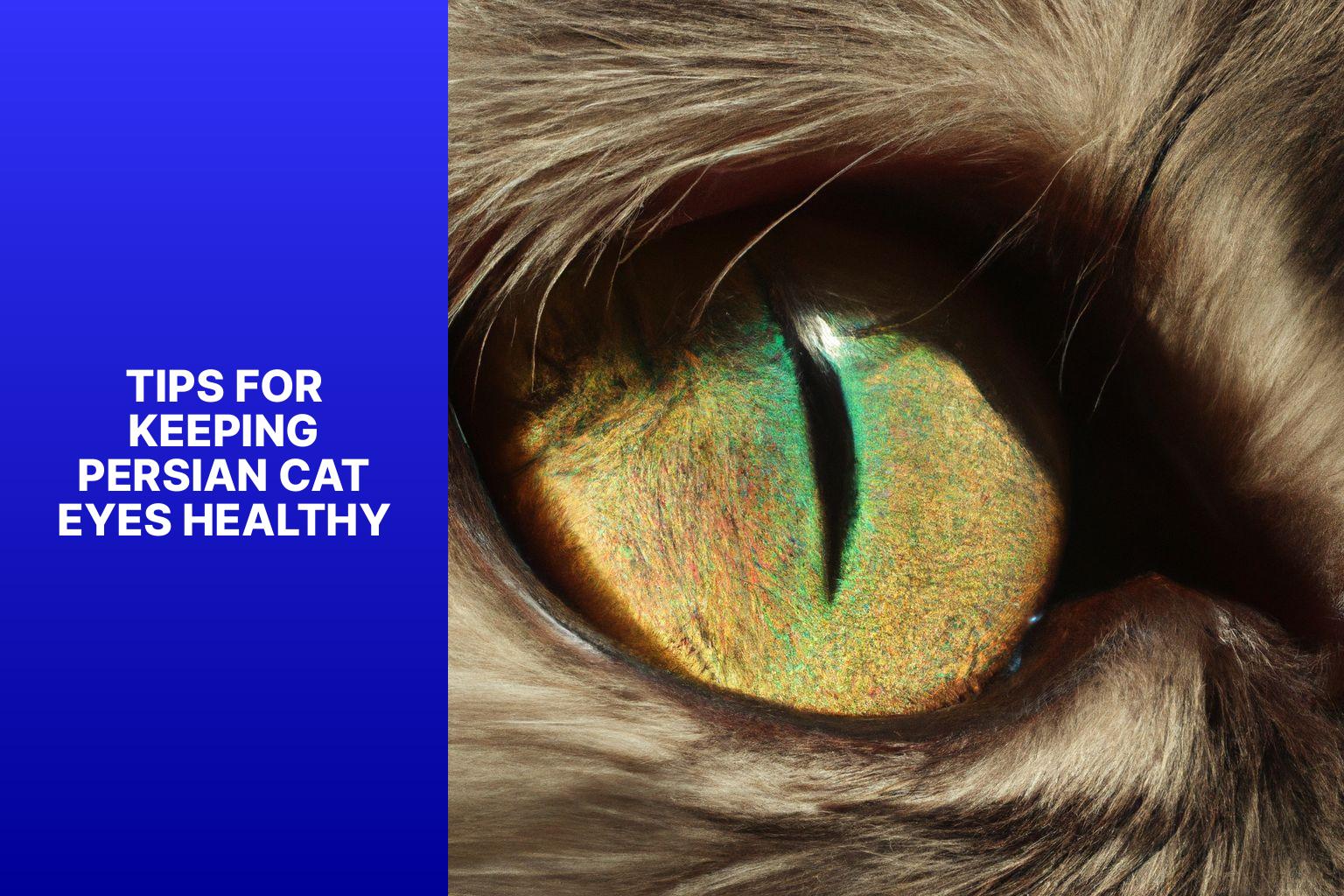Understanding Persian Cat Eyes is essential for maintaining the health and well-being of your beloved feline companion. Persian cats are known for their distinctive and captivating eyes, which require special attention and care. In this article, we will discuss what makes Persian cat eyes different, common eye issues that they may face, and most importantly, how to properly clean their eyes. By following the right techniques and keeping their eyes clean, you can help prevent potential infections and ensure optimal eye health for your Persian cat. We will provide some valuable tips for maintaining healthy Persian cat eyes through regular grooming, avoiding irritants, and monitoring their eye health. If you notice signs of eye infections or any other serious issues, it is crucial to seek professional help and consult a veterinarian. Let’s dive into the world of Persian cat eyes and learn the best practices for keeping them clean and healthy.
Key takeaway:
- Understanding Persian Cat Eyes: Persian cat eyes have specific characteristics that make them different from other cats. It’s important to be familiar with these traits to properly care for their eyes.
- How to Clean Persian Cat Eyes: Cleaning a Persian cat’s eyes requires gathering the necessary supplies and following a step-by-step guide. Regular cleaning helps maintain good eye hygiene.
- Tips for Keeping Persian Cat Eyes Healthy: Regular grooming, avoiding irritants, and monitoring their eye health are vital for maintaining the health of Persian cat eyes. These practices contribute to preventing eye issues and infections.
- When to Seek Professional Help: Understanding signs of eye infections or serious issues is essential. If any concerning symptoms arise, it’s important to consult a veterinarian to ensure proper treatment and care for your Persian cat’s eyes.
Understanding Persian Cat Eyes
Persian cats are known for their stunning eyes. These cats have large, round eyes that immediately draw attention. Their eye color can range from captivating shades of blue, green, gold, or copper. One can’t help but notice the sweet and gentle expression in their eyes. It’s important to note that Persian cats are more susceptible to eye-related health issues due to their unique facial structure.
Various eye problems can affect Persians, including tear staining, eye infections, and entropion. Tear staining occurs when tears overflow and leave unsightly stains around the eyes. Eye infections, on the other hand, may be caused by bacteria, viruses, or allergies. Another condition to be aware of is entropion, where the eyelids fold inward, leading to irritation caused by the eyelashes.
To ensure the well-being of Persian cat eyes, proper care and attention are necessary. Regular grooming and eye cleaning play a crucial role in maintaining their ocular health. Carefully clean the area around their eyes using a damp cloth or specialized eye wipes to remove tear stains. It is essential to be vigilant and seek professional help if any signs of eye problems like redness, discharge, or squinting are observed. Consulting a veterinarian will provide the proper diagnosis and necessary treatment for a Persian cat’s eyes.
What Makes Persian Cat Eyes Different?
Persian Cat Eyes: Understanding the Differences
Persian cat eyes are truly unique. So, what makes Persian cat eyes different? Let’s delve into their remarkable features. Their eyes have a distinct large, round shape that gives them an irresistibly adorable and innocent look. The mesmerizing color of their eyes can vary greatly, ranging from captivating blue and entrancing green to captivating gold hues. Some Persian cats even have the peculiar and fascinating odd-eyed trait.
It’s important to note that Persian cats are prone to various eye-related health issues. This is primarily due to their flat face and prominent eyes. These issues include tear staining, infections, and excessive tearing. To ensure the wellbeing of your Persian cat, it is crucial to regularly monitor their eye health. If you notice any symptoms of infection or serious issues, seeking professional help is imperative.
Common Eye Issues in Persian Cats
Common eye issues in Persian cats, such as excessive tearing, corneal ulcers, entropion, conjunctivitis, and cataracts, are important to be aware of. These issues can cause discomfort and affect your cat’s vision.
Excessive tearing in Persian cats is a common problem due to their facial structure and eye shape. This can lead to tear stains and make your cat uncomfortable. It is important to address this issue and keep their eyes clean.
Corneal ulcers are open sores on the outer layer of the eye. Persian cats may be more susceptible to these ulcers due to trauma, infections, or scratches. It is essential to monitor your cat’s eyes and seek veterinary care if you notice any signs of corneal ulcers.
Entropion is a condition where the eyelid rolls inward, causing the eyelashes to rub against the surface of the eye. This can result in irritation, redness, and even corneal injuries. Regular check-ups with a veterinarian can help identify and address this issue.
Conjunctivitis, characterized by inflammation of the clear membrane covering the white part of the eye, can also occur in Persian cats. This can cause redness, discharge, and discomfort. If you observe any symptoms, it is important to consult a veterinarian for proper diagnosis and treatment.
Although less common, Persian cats can develop cataracts, which are cloudy areas that form in the lens of the eye. This can lead to blurred vision or even blindness. Regular monitoring of your cat’s eyes and early intervention can help prevent further complications.
To ensure your Persian cat’s eye health, it is crucial to regularly check for any signs of redness, discharge, or discomfort. If you notice any issues, it is advisable to seek professional advice from a veterinarian. Keeping your cat’s eyes clean and free of tear stains can contribute to preventing future eye problems.
How to Clean Persian Cat Eyes
Tired of dealing with dirty Persian cat eyes? Look no further! Get ready to learn the best methods for sparkling Persian cat eyes in no time. We’ll start by gathering the necessary supplies and then dive into a step-by-step guide to cleaning those beautiful peepers. Say goodbye to stains and discomfort, and say hello to happy and healthy feline eyes!
Gather the Necessary Supplies
When cleaning your Persian cat’s eyes, gather the necessary supplies beforehand. This ensures a smooth and effective process. Here is a list of supplies you need:
- Clean and soft cloths or cotton balls
- Sterile saline solution or eye drops recommended by your veterinarian
- Warm water
- Small, clean bowl or container
- Treats or rewards for your cat’s cooperation
Having these supplies ready saves time and makes the cleaning process more efficient. Use clean and soft materials to avoid further irritation to your cat’s delicate eyes. The sterile saline solution or recommended eye drops gently remove debris or discharge. Use warm water and a small container to wet the cloths or cotton balls for cleaning. Treats or rewards keep your cat calm and cooperative.
True story: One day, while cleaning my Persian cat’s eyes, I realized I had forgotten to gather the necessary supplies beforehand. It was a struggle to find all the items I needed while my cat anxiously waited. Since then, I have learned the importance of being prepared and always having the necessary supplies within reach. It has made the cleaning process easier and less stressful for both me and my furry friend.
Step-by-Step Guide to Cleaning Persian Cat Eyes
To clean Persian cat eyes, follow this guide:
1. Gather necessary supplies:
- Soft, clean cloth or cotton balls
- Warm water
- Mild pet-safe cleanser or saline solution
2. Gently restrain your cat:
- Place your cat in a comfortable position, keeping their head still and stable.
- Use treats or positive reinforcement to keep them calm.
3. Wet the cloth or cotton ball:
- Dip it in warm water or moisten with a saline solution.
4. Clean the eyes:
- Start from the inner corner of the eye, gently wipe outward with the damp cloth or cotton ball.
- Use a new cloth or cotton ball for each eye to prevent cross-contamination.
5. Remove discharge or debris:
- If there’s any discharge or debris around the eyes, gently remove it with a separate cloth or cotton ball.
- Avoid touching the eyeball itself.
6. Repeat if necessary:
- Depending on the amount of dirt or discharge, you may need to repeat the cleaning process for both eyes.
7. Monitor your cat’s reaction:
- Observe your cat’s behavior during and after cleaning.
- If they show signs of discomfort or irritation, stop immediately and seek professional help.
Maintaining regular eye cleaning is essential for keeping Persian cat eyes healthy. Consult your veterinarian for specific concerns or eye issues your cat may have. By following this guide, you can ensure proper care for your Persian cat’s eyes.
Tips for Keeping Persian Cat Eyes Healthy
Photo Credits: Www.Catcornerblog.Com by Roy Nguyen
If you want your Persian cat’s eyes to sparkle with health, then you’re in the right section. Here, we’ll dive into some valuable tips for keeping those captivating feline eyes in top shape. From the importance of regular grooming to avoiding irritants and monitoring their eye health, we’ve got you covered. So buckle up, cat lovers, and get ready to learn how to ensure your Persian cat’s eyes are as bright and beautiful as ever!
Regular Grooming
Regular grooming plays a crucial role in maintaining the health and appearance of Persian cat eyes. To ensure proper grooming, follow these steps:
1. Inspect the eyes regularly to check for any signs of discharge, redness, or infection.
2. Clean the surrounding area by gently wiping it with a clean, damp cloth to remove any dirt or debris.
3. Trim long hair around the eyes using rounded-tip scissors to prevent obstruction of vision.
4. If the eyes appear dry or irritated, consult a veterinarian for suitable eye drops or ointments.
5. When grooming, always be gentle to avoid causing any discomfort or injury to your cat. If your cat becomes distressed or anxious, take a pause and provide reassurance.
Remember, regular grooming not only keeps Persian cat eyes clean and healthy but also helps in strengthening the bond between you and your beloved furry friend. By following a routine with necessary precautions, you can ensure the well-being of their precious eyes.
Avoiding Irritants
Edited
Avoiding Irritants
To avoid irritants for Persian cat eyes, consider the following factors. Keep their environment clean and free from dust, smoke, and other airborne particles that may cause irritation. Regularly dust and vacuum the living area to minimize exposure to these irritants. Also, keep the litter box clean and use unscented litter to prevent the release of chemicals that may irritate the cat’s eyes.
Choose the right grooming and cleaning products. Use gentle and hypoallergenic products specifically formulated for cats to prevent eye irritation. When bathing your Persian cat, be cautious not to get shampoo or water into their eyes, as this can cause discomfort and irritation.
Monitor your cat’s behavior for signs of eye irritation, such as excessive tearing, redness, or discharge. If you notice any of these symptoms, consult a veterinarian for proper diagnosis and treatment.
Pro-tip: Regularly wipe your cat’s face with a damp cloth to remove any irritants that may have come into contact with their eyes. This simple practice promotes eye health and minimizes the risk of irritation.
Monitoring Eye Health
Monitoring eye health is important for maintaining the well-being of your Persian cat. Regularly observe and check their eyes for any changes in color, shape, or discharge. It is crucial to incorporate monitoring eye health into your cat’s routine care.
Look for redness, swelling, or irritation as these could be signs of underlying issues. Excessive tearing may indicate a blockage or infection in the tear ducts. Pay close attention to squinting or frequent blinking, as it may be a sign of discomfort or pain.
Actively monitoring your cat’s behavior for changes such as increased sensitivity to light or reluctance to fully open their eyes is essential. If you notice any concerning symptoms or changes, seek professional help from a veterinarian for a thorough examination and appropriate treatment.
Remember, proactive monitoring and early intervention can maintain your Persian cat’s eye health and overall well-being.
When to Seek Professional Help
When it comes to the well-being of our beloved Persian cats, knowing when to seek professional help is crucial. In this section, we’ll uncover the signs of eye infections or other serious issues that require immediate attention. We’ll explore the importance of consulting a veterinarian to ensure our feline friends receive the proper care they need. So let’s dive in and become informed advocates for the health and happiness of our Persian cat’s eyes.
Signs of Eye Infections or Other Serious Issues
Signs of eye infections or other serious issues in Persian cats may indicate the need for immediate veterinary care. It is important to be aware of these signs to ensure your cat’s eye health:
– Redness and inflammation: If you notice redness or swelling around your cat’s eyes, it could be a sign of an eye infection or another serious issue.
– Discharge: Excessive discharge from the eyes, including pus or mucus, can indicate an eye infection.
– Cloudiness or opacity: A change in the clarity of your cat’s eyes may suggest the development of a serious condition like cataracts.
– Excessive tearing: While some tearing is normal, excessive tearing or persistent watery eyes can be a sign of an underlying problem, such as an eye infection.
– Changes in behavior: If your cat frequently paws at their eyes, squints, or avoids bright lights, it may indicate pain or discomfort caused by an eye infection or other serious issue.
Recognizing these signs and seeking prompt veterinary attention is crucial to prevent further complications and ensure your Persian cat’s eye health. Regular veterinary check-ups are also important for monitoring and maintaining your cat’s overall eye health.
Fact: Persian cats are prone to certain eye conditions, including progressive retinal atrophy (PRA) and polycystic kidney disease (PKD), which can affect their vision. Regular eye examinations can help detect and manage these conditions early.
Consulting a Veterinarian
When it comes to your Persian cat’s eye well-being, it is extremely important to consult a veterinarian. There are several reasons why seeking professional help is crucial:
- If you notice any signs of eye infections such as redness, swelling, discharge, or excessive blinking, it is advisable to consult a veterinarian. They have the expertise to diagnose the problem accurately and provide the necessary treatment.
- It is also important to understand that other serious issues, including underlying health conditions or injuries, can directly impact your Persian cat’s eyes. In such cases, consulting a veterinarian is essential as they can identify these issues and recommend appropriate interventions.
Allow me to share a true story with you. I once had a beautiful Persian cat named Luna who unfortunately developed a severe eye infection. Her eyes were red, swollen, and she was clearly in discomfort. Without delay, I reached out to a veterinarian who promptly prescribed the required medication and provided me with guidance on how to take care of Luna’s eyes. Through consistent treatment and regular follow-ups, Luna’s eyes gradually cleared up, and she regained her playful spirit. This entire experience clearly demonstrated how consulting a veterinarian helped restore Luna’s eye health and improve her overall well-being.
Some Facts About How to Clean Persian Cat Eyes:
- ✅ Tear stains around the eyes can be a common issue for Persian cats. (Source: Our Team)
- ✅ Persian cats have unique facial structures that can cause problems with their eyes. (Source: Our Team)
- ✅ Cleaning your Persian cat’s eyes on a daily basis can help reduce eye debris build-up and fur staining. (Source: Our Team)
- ✅ Daily eye cleanings should help clear up tear-stained fur without the need for expensive fur-cleaning products. (Source: Our Team)
- ✅ Excessive eye drainage is not harmful to Persian cats, but it can lead to eye infections if not properly managed. (Source: Our Team)






